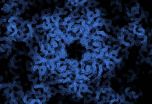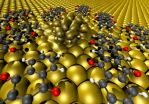(Press-News.org) Some 90,000 patients per year are treated for Parkinson's disease, a number that is expected to rise by 25 percent annually. Deep Brain Stimulation (DBS), which consists of electrically stimulating the central or peripheral nervous system, is currently standard practice for treating Parkinson's, but it can involve long, expensive surgeries with dramatic side effects. Miniature, ultra-flexible electrodes developed in Switzerland, however, could be the answer to more successful treatment for this and a host of other health issues.
Today, Professor Philippe Renaud of the École Polytechnique Fédérale de Lausanne (EPFL) in Switzerland reports on soft arrays of miniature electrodes developed in his Microsystems Laboratory that open new possibilities for more accurate and local DBS. At the 2013 Annual Meeting of the American Association for the Advancement of Science (AAAS) in Boston, in a symposium called "Engineering the Nervous System: Solutions to Restore Sight, Hearing, and Mobility," he announces the start of clinical trials and early, yet promising results in patients, and describes new developments in ultra-flexible electronics that can conform to the contours of the brainstem—in the brain itself—for treating other disorders.
At AAAS, Renaud outlines the technology behind these novel electronic interfaces with the nervous system, the associated challenges, and their immense potential to enhance DBS and treat disease, even how ultra flexible electronics could lead to the auditory implants of the future and the restoration of hearing. "Although Deep Brain Stimulation has been used for the past two decades, we see little progress in its clinical outcomes," Renaud says. "Microelectrodes have the potential to open new therapeutic routes, with more efficiency and fewer side effects through a much better and finer control of electrical activation zones." The preliminary clinical trials related to this research are being done in conjunction with EPFL spin-off company Aleva Neurotherapeutics, the first company in the world to introduce microelectrodes in Deep Brain Stimulation leading to more precise directional stimulation.
###
More information:
Researcher Contact:
Professor Philippe Renaud
philippe.renaud@epfl.ch
Microsystems Laboratory 4 : http://lmis4.epfl.ch/
Press Kit:
http://bit.ly/VJtgH5
About EPFL:
With over 350 laboratories and research groups on campus, EPFL is one of Europe's most innovative and productive
scientific institutions. Ranked top 3 in Europe and top 20 worldwide in many scientific rankings, EPFL
has attracted the best researchers in their fields.
The institute's unique structure fosters trans-disciplinary research and promotes partnerships with other institutions. It continuously combines fundamental research and engineering. http://information.epfl.ch/glance END
Fighting disease deep inside the brain
2013-02-18
ELSE PRESS RELEASES FROM THIS DATE:
The quest for a better bionic hand
2013-02-18
For an amputee, replacing a missing limb with a functional prosthetic can alleviate physical or emotional
distress and mean a return of vocational ability or cosmetics. Studies show, however, that up to 50 percent of
hand amputees still do not use their prosthesis regularly due to less than ideal functionality, appearance, and
controllability.
But Silvestro Micera, of the École Polytechnique Fédérale de Lausanne (EPFL) in Switzerland, is paving the way
for new, smart prosthetics that connect directly to the nervous system. The benefits are more versatile prosthetics
with ...
Arrhythmia culprit caught in action
2013-02-18
Using powerful X-rays, University of British Columbia researchers have reconstructed a crime scene too small for any microscope to observe – and caught the culprit of arrhythmia in action.
Characterized by the heart beating too fast, too slow or inconsistently, arrhythmias may cause a decrease of blood flow to the brain and body, resulting in heart palpitation, dizziness, fainting, or even death.
Presented today at the 2013 Annual Meeting of the American Association for the Advancement of Science (AAAS) in Boston, the 3D animated model reveals for the first time how ...
Food science expert: Genetically modified crops are overregulated
2013-02-18
CHAMPAIGN, Ill. — It has been almost 20 years since the first genetically modified foods showed up in produce aisles throughout the United States and the rest of the world, but controversy continues to surround the products and their regulation.
Bruce Chassy, a professor emeritus of food science and human nutrition at the University of Illinois at Urbana-Champaign, believes that after thousands of research studies and worldwide planting, "genetically modified foods pose no special risks to consumers or the environment" and are overregulated.
Chassy will elaborate on ...
Media advisory: AAAS session addresses city infrastructure design in a changing climate
2013-02-18
DURHAM, N.H. – As our climate changes, the way we engineer our cities must, too. That's the message that University of New Hampshire professor Paul Kirshen, an author of a recent report that assessed Boston's vulnerability to coastal flooding, will deliver at the American Association for the Advancement of Science (AAAS) Annual Meeting February 14-18, 2013, in Boston.
Kirshen will speak coastal adaptation planning for vulnerable communities in the "Environmental Challenges and Adaptation in Cities" session (3 – 4:30 p.m., Room 308, Hynes Convention Center). He'll present ...
Modern alchemy, fusion energy and more from Princeton
2013-02-18
A possible Higgs boson of cancer and steps to give natural biodiversity a fighting chance will be among the topics Princeton University researchers will discuss during the 2013 AAAS annual meeting. Below are summaries, arranged chronologically, of the research to be presented. All information is embargoed until the beginning of the respective session.
* Virtual water trade helps cope with climate change
Ignacio Rodriguez-Iturbe, James S. McDonnell Distinguished University Professor of Civil and Environmental Engineering
Friday, Feb. 15, 8 a.m., Room 203
Climate change ...
Synthetic molecule first electricity-making catalyst to use iron to split hydrogen gas
2013-02-18
RICHLAND, Wash. -- To make fuel cells more economical, engineers want a fast and efficient iron-based molecule that splits hydrogen gas to make electricity. Online Feb. 17 at Nature Chemistry, researchers report such a catalyst. It is the first iron-based catalyst that converts hydrogen directly to electricity. The result moves chemists and engineers one step closer to widely affordable fuel cells.
"A drawback with today's fuel cells is that the platinum they use is more than a thousand times more expensive than iron," said chemist R. Morris Bullock, who leads the research ...
Diamond sheds light on basic building blocks of life
2013-02-18
The UK's national synchrotron facility, Diamond Light Source, is now the first and only place in Europe where pathogens requiring Containment Level 3 – including serious viruses such as those responsible for AIDS, Hepatitis and some types of flu – can be analysed at atomic and molecular level using synchrotron light. This special light allows scientists to study virus structures at intense levels of detail and this new facility extends that capability to many viruses that have a major global impact on human and animal health. Studying pathogens in this way has the potential ...
Organic electronics -- how to make contact between carbon compounds and metal
2013-02-18
Until now, however, it was practically impossible to accurately predict which molecules performed well on the job. They basically had to be identified by trial-and-error.
Now, an international team of scientists around Dr. Georg Heimel and Prof. Norbert Koch from the HZB and the Humboldt University Berlin has unraveled the mystery of what these molecules have in common. Their discovery enables more focused improvements to contact layers between metal electrodes and active materials in organic electronic devices.
"We have been working on this question for a number of ...
'Activating' RNA takes DNA on a loop through time and space
2013-02-18
Long segments of RNA— encoded in our DNA but not translated into protein—are key to physically manipulating DNA in order to activate certain genes, say researchers at The Wistar Institute. These non-coding RNA-activators (ncRNA-a) have a crucial role in turning genes on and off during early embryonic development, researchers say, and have also been connected with diseases, including some cancers, in adults.
In an online article of the journal Nature, a team of scientists led by Wistar's Ramin Shiekhattar, Ph.D., detail the mechanism by which long non-coding RNA-activators ...
Dopants dramatically alter electronic structure of superconductor
2013-02-18
UPTON, NY - Over the last quarter century, scientists have discovered a handful of materials that can be converted from magnetic insulators or metals into "superconductors" able to carry electrical current with no energy loss-an enormously promising idea for new types of zero-resistance electronics and energy-storage and transmission systems. At present, a key step to achieving superconductivity (in addition to keeping the materials very cold) is to substitute a different kind of atom into some positions of the "parent" material's crystal framework. Until now, scientists ...


